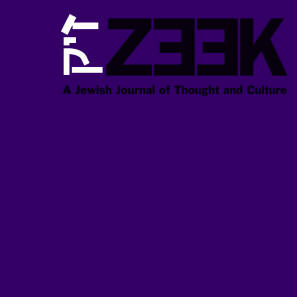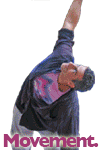 April 07
April 07
Shoot Your Tired, Your Poor, Your Huddled Masses: The Biblical Stories of Adi Nes
by Susan Chevlowe
p. 2 of 2
In the photograph, Nes chooses a model with features resembling Dorothea Lange's Migrant Mother (1936), and even poses her and styled her hair similarly. Lange's stark black-and-white image, considered the very quintessence of the documentary mode, is acknowledged in Nes's almost ashen hues. Widely published during the Depression, Lange’s photograph remains an iconic image from the period. Nes's allusion to specifically social documentary photography, here and in other series, extends his photographs’ meaning from the particularity of poverty and oppression in Israel to general conditions in contemporary society.
Like Lange's migrant mother, Nes's Hagar is uprooted and homeless. Lange's mother, her face showing signs of age beyond her thirty-two years, touches the side of her mouth near her chin; Hagar, too, covers her mouth in worry, maybe also in shock. Both women look out of the picture without confronting the camera. Nonetheless, Nes’s picture differs significantly from Lange’s, which included two of the woman’s children who cling to her. In Nes's image, Hagar’s despair is intensified by the very fact that her son is missing from the picture; poignantly, she makes a cupping gesture with her left hand as a sign of that emptiness.
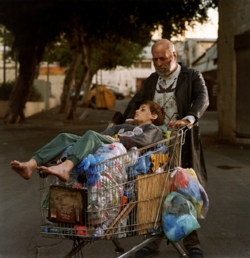 Abraham and Isaac (2004)
Abraham and Isaac (2004)
In the biblical story God tests Abraham’s faith by commanding him to sacrifice Isaac on Mount Moriah. When they arrive at their destination, Abraham binds Isaac to the altar and raises his hand to slaughter him. At the last possible moment, a messenger of God appears and stops Abraham by providing him with a ram that he can offer instead. Abraham merits God’s blessings due to his devotion. Nes has based this composition on Duane Hanson's Pop-era Supermarket Shopper (1970), which featured an absurdly made-up woman pushing a cart full of food – not a particularly political work at the time, but in retrospect an indictment of American consumerism and overabundance at a time when much of the world went hungry.
Nes’s Abraham is another homeless figure, old and unkempt, a familiar sight in some of the wealthiest cities in the world, where the destitute make their living collecting cans and bottles for recycling. He carries his young son, Isaac, asleep on top of the trash that fills his shopping cart. Abraham intentionally resembles Caravaggio's Abraham in The Sacrifice of Isaac (1601-02). Significantly, Nes’s portrayal of a serene Isaac is a more Jewish interpretation of the story than Caravaggio gave it: according to a midrash, Isaac, who was thirty-seven at the time, understood what was happening and did not resist his father out of filial respect. As in other photographs from the series, Nes does not illustrate a particular moment in the story. He leaves open the question of whether Abraham is on his way to Mount Moriah or returning from there. He also leaves the meaning of the cart itself ambiguous: only the burnt pieces of wood sticking out from its sides suggest that the cart itself may represent the altar. The idea that the cans and bottles in the cart will be redeemed suggests a further play on the redemption of Isaac, who is redeemed by the sacrifice of the ram in his place. But whether that will happen in this case remains to be seen.
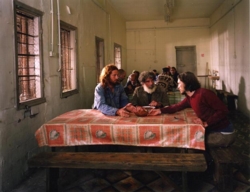 Jacob and Esau (2006)
Jacob and Esau (2006)
The twins Jacob and Esau are different from each other in appearance and temperament. Much of the biblical commentary denigrates Esau as duplicitous and idolatrous, while praising Jacob for his high morals and studiousness, and affirming his efforts to secure his inheritance and his fulfillment of God's covenant with Abraham (Gen. 17:3-8). Nonetheless, the biblical story of the two brothers does not dwell on the complexity of their rivalry, nor on the intricate nuances of both their characters. This is what fascinates Nes. He depicts the moment when Esau sells Jacob his birthright in exchange for a bowl of lentil stew. According to commentators, Esau’s contempt for his birthright proved that he had been “neither duped nor defrauded….it had no value to him when he was famished and it remained meaningless after he was gorged” (Rabbi Nosson Scherman, ed., The Chumash, 1993). In the photograph, Nes departs from the biblical story, adding his own midrash by including Isaac at the table. Esau sits to his father's privileged side, at the right hand of Isaac and close to him; Jacob is at a distance, to his left.
The contemporary setting in Nes's photograph is a soup kitchen, and the composition is based on Caravaggio's Supper at Emmaus (1606). Nes exploits Caravaggio's dramatic handling of light in the depiction of Jacob’s profile, the strong shadows cast on the wall and the halo-like projection coming through the window onto the back of Esau’s head. Although a redhead, Esau has the traditional features of Jesus. He sits upright and composed, with his arms outstretched toward the bowl of lentils that the dark haired and swarthy Jacob pushes toward him across the table. In Nes's reading of the story, the visual codes that suggest moral and ethical lessons to the viewers are ambivalent. The allusion to the Supper at Emmaus also adds another layer of meaning. The Gospel of Luke relates that on the day of the resurrection Jesus appeared to two disciples on the road to Emmaus and was invited by them to eat something although they did not recognize him. During the meal Jesus revealed himself and then disappeared. The composition’s echo of Da Vinci’s Last Supper, along with Esau's resemblance to conventional representations of Jesus and Jacob’s to Judas, also underscore the moral ambivalence of Jacob’s actions. Nes sees even the soup kitchen, where everyone is wanting, as pervaded by an atmosphere of deceit and manipulation.
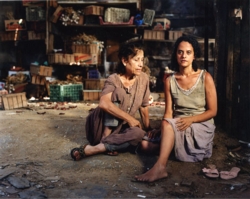 Ruth and Naomi (2006)
Ruth and Naomi (2006)
The Book of Ruth is deeply connected to the story of King David and to the giving of the Torah which occurred during Shavuot, marking the spring harvests of barley and wheat. After their husbands had died, Naomi, a refugee from Judea who fled to Moab during a period of famine, decided to return to her homeland and started out with her daughters-in-law, but then told them to return to their own mothers to find new husbands. One, Orpah, obeyed, but the other, Ruth, stubbornly refused, declaring to Naomi, “Your people are my people, your God, my God” (Ruth 1:16), and she vowed to die before being separated from her. Though the biblical story stresses Naomi’s belief that the women must find husbands to care for them, Nes emphasizes Ruth and Naomi’s self-reliance and mutual dependence. Ruth – whose name means compassion – in dedicating herself to Naomi and to her people is sometimes popularly referred to as a convert to Judaism, giving a remarkable genealogy to her great-grandson, King David.
Naomi and Ruth returned to Bethlehem at the beginning of the barley harvest. With Naomi’s approval, Ruth went to glean fallen grain from a field being harvested as was customary for the poor to do in those days. Boaz, the landowner, appeared and became interested in her. He was generous, providing her with food and comfort. When Naomi learned that it was Boaz’s field on which Ruth had been working, she encouraged her daughter-in-law to entice Boaz who, in the language of the Bible, agreed to redeem her in appreciation for her loving kindness toward him. Naomi’s motivation has been understood as manifesting her belief that a marriage between Ruth and Boaz will reinstate her community standing as well as secure entitlement to lost family property.
The agricultural landscapes described in the Book of Ruth found their counterparts in photographic images of the Holy Land. In Nes’s photograph, the fields of Eretz Israel have been replaced by a modern open air market in which the poor glean leftovers at the end of the day. In Nes’s interpretation, Naomi has joined Ruth in this undertaking. In a field whose utter chaos marks a site of destruction, scarcity, and disruption, rather than the fruits and promise of the land, the women have been posed like the figures in Millet’s The Gleaners of 1857, a work in which the rural peasants were represented with great dignity and nobility. In photography in pre-State Israel women were often seen cultivating the land, workers on an equal footing with men in the service of nation building. As Irit Rogoff has suggested in her 1998 book Terra Infirma: Geography’s Visual Culture, such representations of the bodies of women who nurtured and made the land fertile were “used to make claims to the land and to render those claims naturalized and organic” (p. 159). In Nes’s photograph the women are scavengers rather than nurturers of the land, thus their representations speak to and deconstruct such earlier representations.
Susan Chevloweis adjunct assistant professor in the Program in Jewish Art and Visual Culture at the Jewish Theological Seminary in New York. A former curator at The Jewish Museum, New York, she has organized more than a dozen exhibitions of modern and contemporary art. Her publications include the exhibition catalogues Painting a Place in America: Jewish Artists in New York, 1900-1945 (co-edited with Norman Kleeblatt); Common Man, Mythic Vision: The Paintings of Ben Shahn; and The Jewish Identity Project: New American Photography. This essay has been adapted from Adi Nes’s Biblical Stories (Tel Aviv: Tel Aviv Museum of Art, 2007).
